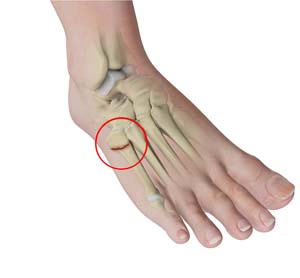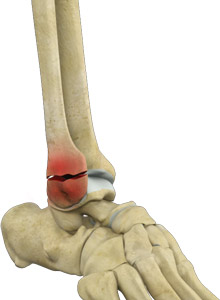Foot and Ankle Fractures
Foot Fractures

What is the Normal Anatomy of the foot?
The foot has 26 bones, and can be divided into 3 parts:
- The hind foot is comprised of two bones, the talus bone which connects to the bones of the lower leg, and the calcaneus bone which forms the heel.
- The midfoot is comprised of the navicular, cuboid, and three cuneiform bones.
- The forefoot is made up of five metatarsal bones and 14 toe bones called phalanges.
The hind foot is separated from the midfoot by the medio tarsal joint and the midfoot is separated from the forefoot by the Lisfranc joint. Muscles, tendons and ligaments support the bones and joints of the feet enabling them to withstand the entire weight of the body while walking, running and jumping.
What is a Foot Fracture?
Trauma and repeated stress can cause fractures in the foot. Extreme force is required to fracture the bones in the hind foot. The most common type of foot fracture is a stress fracture, which occurs when repeated activities produce small cracks in the bones.
What are the Types of Foot Fractures?
Foot fractures can involve different bones and joints and are classified into several types:
- Calcaneal fractures: This affects the heel bone and occurs mostly because of high-energy collisions. It can cause disabling injuries and if the subtalar joint is involved it is considered a severe fracture.
- Talar fractures: The talus bone helps to transfer weight and forces across the joint. Talus fractures usually occur at the neck or mid portion of the talus.
- Navicular fractures: Navicular fractures are rare and include mostly stress fractures that occur with sports activities, such as running and gymnastics, because of repeated loading on the foot.
- Lisfranc fractures: This type of fracture occurs due to excessive loading on the foot, which leads to stretching or tearing of the midfoot ligaments.
What are the Common Causes of Foot Fractures?
Foot fractures commonly occur because of a fall, motor vehicle accident, dropping a heavy object on your foot, or from overuse such as with sports.
What are the Symptoms of Foot Fractures?
The common symptoms of a foot fracture include pain, bruising, tenderness, swelling, deformity and inability to bear weight.
How are Foot Fractures Diagnosed?
Your doctor diagnoses a foot fracture by reviewing your medical history and performing a thorough physical examination of your foot. Imaging tests such as X-rays, MRI or CT scan may be ordered to confirm the diagnosis. Navicular fractures can be especially difficult to diagnose without imaging tests.
What is the Treatment for Foot Fractures?
Treatment depends on the type of fracture sustained. For mild fractures, non-surgical treatment is advised and includes rest, ice, compression, and elevation of the foot. Your doctor may suggest a splint or cast to immobilize the foot. For more severe fractures, surgery will be required to align, reconstruct or fuse the joints. Bone fragments may be held together with plates and screws.
Physical therapy may be recommended to improve range of motion and strengthen the foot muscles. Weight-bearing however, should be a gradual process with the help of a cane or walking boot.
Ankle Fracture

What is an Ankle Fracture?
An ankle fracture is a break in one or more bones that make up the ankle joint. Sometimes, ligaments may also be damaged. Ankle fractures are most often caused by motor vehicle accidents, rolling or twisting of the ankle, and by tripping or falling. People participating in sports such as basketball, football, soccer and skiing are at a high risk of developing ankle fractures.
Symptoms of Ankle Fractures
Common symptoms of an ankle fracture include pain and swelling around the ankle, bruising, tenderness, inability to walk on the leg, and deformity if the ankle is dislocated.
Diagnosis of Ankle Fractures
Following an ankle injury, it is important to have the ankle evaluated by your doctor for proper diagnosis and treatment. Diagnosis is made based on the history of injury and physical examination of the ankle. In addition, the surgeon may order X-ray of the ankle to determine the extent of the injury.
Treatments of Ankle Fractures
Treatment varies with the type and severity of the injury. The common method of treatment of ankle fractures is adequate rest, ice application, leg elevation, and medications to reduce swelling and pain. A short leg cast or a brace may be applied over the fractured ankle to provide support. If there is severe injury, excessive swelling or severe pain, you should seek immediate medical treatment.
Some ankle fractures are treated with a splint, which is placed on the ankle for a few days until the swelling subsides. Once the swelling decreases, a cast may be placed on the ankle to hold the broken bone in place. Surgery may be needed to realign the bones before placing the splint. During surgery, your doctor may place metal screws, plates, or rods to hold the broken bones intact until healing happens. In some cases, crutches may be used to prevent weight-bearing on the ankle.






